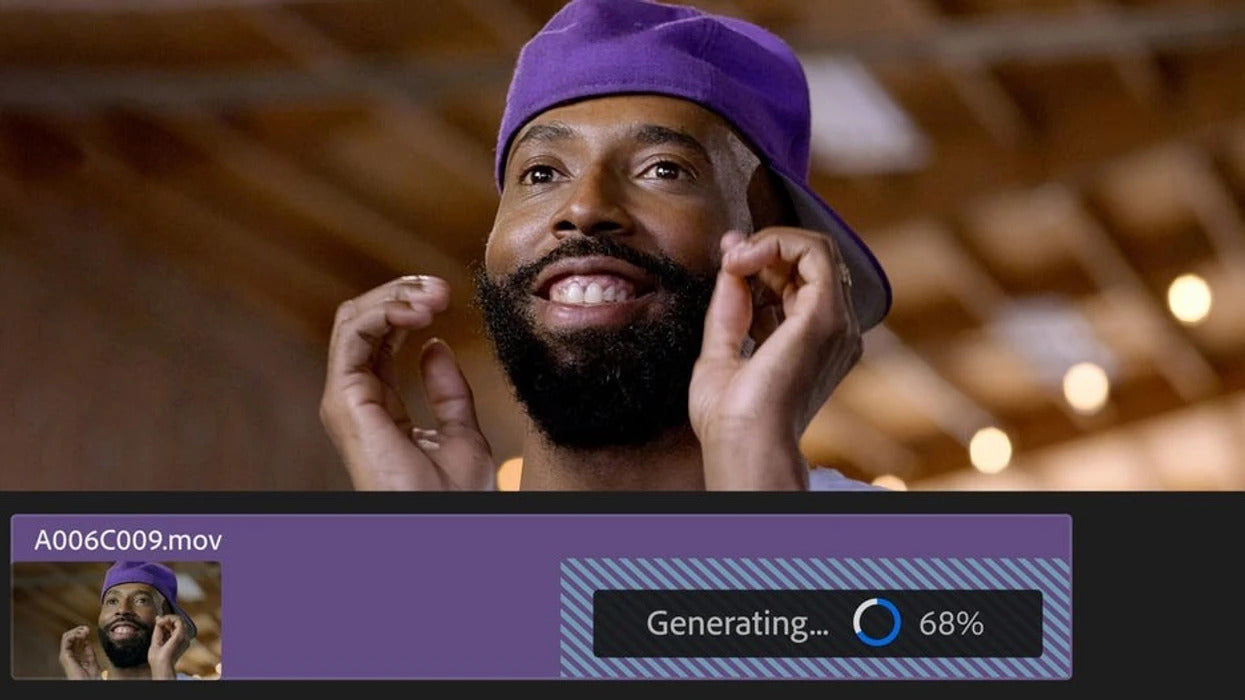A comprehensive AI sector study – conducted by the Department for Science, Innovation and Technology (DSIT) in collaboration with Perspective Economics, Ipsos, and glass.ai – provides a detailed overview of the industry’s current state and its future prospects. In this article, we delve deeper into the…
End GPU underutilization: Achieve peak efficiency
AI and deep learning inference demand powerful AI accelerators, but are you truly maximizing yours? Find out how to achieve peak efficiency with your GPUs in this live session….
BirdDog X4 Ultra PTZ Camera: Unveiling the Future of 4K Livestreaming – Videoguys

On this week’s Videoguys Live, James is joined by Cameron from BirdDog to introduce the BirdDog X4 Ultra PTZ Camera. Learn about its advanced features and how it enhances 4K livestreaming and video production. Discover the latest innovation in the X-Series lineup including the X4 Ultra, X5 Ultra, and X1 Ultra, and the X1.
[embedded content]
Say hello to the X-Factor Upgrade from BirdDog! Register your current PTZ Camera (any brand and any model) with BirdDog and receive an exclusive coupon code to save on BirdDog’s next generation of PTZ cameras; the X1 Ultra, X4 Ultra, and X5 Ultra.
Step 1: Register Your Current Camera (Any Brand) with BirdDog
Step 2: Purchase a BirdDog Next-Gen Camera with your Exclusive Discount Code
with X-FACTOR Coupon |
with X-FACTOR Coupon |
with X-FACTOR Coupon |
|
with X-FACTOR Coupon |
Performance
- Maximum 4K60 performance
- 33% larger image sensor
- Highest quality ISP (Image Signal Processing)
- WiFI 6 2×2 MIMO for long-range reliability
Wireless Receiver Station
|
Connectivity
- Built with purpose, any purpose
- NDI|HX3
- 3G-SDI
- HDMI 2.0
- USB-C
- Maximum control compatibility
- NDI, VISCA, USB, Serial, API
- Optional wireless receiver station
Next-Gen BirdDog UI
- More interactive
- Faster
- Immersive control
- Unified screens
- AI control centre
Design
- Available in black or white for multiple applications
- Blends in with architectural spaces
- Customizable e-Ink displays for branding
- Bulit-in HALO tally system
- Various mounting options
X4 Ultra Use Cases
- Mid-High level live production
- Product training, announcements (internal comms)
- Event spaces
- Houses of worship
- Corporate communications
- High-end meeting spaces
- Education
- Medical
Click Here to view the BirdDog X-Series Comparison Chart
|
with X-FACTOR Coupon |
|
with X-FACTOR Coupon |
|
BirdDog MAKI Ultra Box Cameras
|
Adobe’s Firefly AI is Set to Revolutionize Video Editing – Videoguys

In this article by Jourdan Aldredge for NoFilmSchool, the author explores how Adobe’s new Firefly AI-powered video model is set to revolutionize video editing. With updates across Adobe Premiere Pro, After Effects, and Frame.io, Firefly introduces game-changing features like Generative Extend to help video editors work more efficiently. These updates were revealed during Adobe’s MAX 2024 conference, held in Miami, Florida.
One of the most exciting additions to Premiere Pro is the Generative Extend (beta) feature, which allows users to extend the length of video clips by generating new frames. This AI-powered tool enables video editors to fill gaps in footage, smooth transitions, and hold shots for the perfect edit. It also extends audio clips by generating ambient “room tone” to make transitions sound natural. This feature will save editors significant time while maintaining professional quality in their video projects.
Adobe’s Firefly AI also brings several improvements across its platforms. Premiere Pro introduces a new color management system that delivers more accurate HDR and SDR color transformations, making video production smoother and more vibrant. Performance enhancements, such as faster ProRes exports and expanded camera support for Canon, Sony, ARRI, and RED, further streamline workflows for editors working with high-resolution footage.
For motion designers using After Effects, Adobe’s integration with Substance 3D adds more creative power by enabling the import of 3D models with ease. This feature allows artists to incorporate stunning, photorealistic 3D elements directly into their projects, boosting productivity and creative potential. Meanwhile, Frame.io simplifies collaboration with new tools for managing complex workflows, richer feedback, and the ability to organize media with customizable metadata.
With these innovations, Adobe Firefly is positioned to be a game-changer for professionals across the video editing industry. Whether you’re editing in Premiere Pro, working on VFX in After Effects, or collaborating through Frame.io, these AI-powered tools promise to make video production faster, more efficient, and more creative than ever before.
Read the full article by Jourdan Aldredge for NoFilmSchool HERE
Fixify Secures $25 Million in Series A Funding to Revolutionize IT Help Desks with AI and Human Experts
Fixify, an innovative company combining AI with human expertise to enhance IT help desks, has successfully raised $25 million in a Series A funding round. This investment, co-led by Costanoa Ventures, Decibel Partners, and Paladin Capital Group, with participation from Scale Venture Partners, will be used…
How LLM Unlearning Is Shaping the Future of AI Privacy
The rapid development of Large Language Models (LLMs) has brought about significant advancements in artificial intelligence (AI). From automating content creation to providing support in healthcare, law, and finance, LLMs are reshaping industries with their capacity to understand and generate human-like text. However, as these models…
30+ Business & Corporate Report Templates for InDesign & Photoshop – Speckyboy

Business reports can span a wide array of use cases. You need everything from large annual reports to single-page product sheets. Not to mention all manner of niche documents.
There’s often a time crunch when putting these reports together. That means less time for crafting a detail-oriented design from scratch. So, how can you balance the need for efficiency and a great look?
The business and corporate report templates in this collection are the perfect solution. They’re predesigned and built for customization and work with popular Adobe apps, including InDesign and Photoshop.
Check out the options below, choose your favorites, and customize them to match your brand. It’s an easy way to speed up your workflow. The time you save will help you hit those deadlines. What’s more, you can use these templates again and again.
Corporate Report Templates
Create beautiful multi-page books and brochures with these corporate report templates. They feature a variety of professional designs and paper sizes. Each can be customized with your organization’s logo, colors, and content.
Annual Report Templates
An organization’s annual report should have a clean and easy-to-read layout. That’s exactly what you’ll find in this collection. Readers will appreciate the top-notch typography and colorful charts that guide them through the document.
Sales & Data Sheet Templates
Use these sales and data sheet templates to give customers the information they need in style. Include product specifications to help them make the choice. And don’t forget to include plenty of photos. These templates have space for both!
Cashflow Report Templates
Every business needs to know where they stand financially. The templates here offer a clean and concise design and are perfect for sharing those important figures. Add your data and provide readers with a clear picture.
Business Plan Templates
A great business plan also needs a compelling design. Readers need to know what makes your company great and how you’ll achieve your goals. Use these templates to bring your business plan to life by taking advantage of their stunning looks and impressive layouts.
Take Your Reports to the Next Level with Ease
Reports are essential to running any business. Stakeholders need to know about profits, project status, and upcoming plans. There’s so much information to communicate.
These publications must also look professional and accurately represent your brand. It’s a tall order for any graphic designer.
The templates in this collection do the heavy lifting for you. They allow you to focus on the task at hand. You don’t need to work harder – just smarter!
Related Topics
Top
Archy Raises $15M to Revolutionize Dental Practices with AI-Driven Automation
In a major step toward transforming dental practices, Archy has secured $15 million in a Series A funding round. Led by Entrée Capital, with participation from Bessemer Venture Partners, CRV, Alven, and the 20VC Growth fund, this investment will accelerate the development of Archy’s AI-powered, cloud-based…
Clarifying the Relationship Between Popovers and Dialogs
The difference between Popovers (i.e., the popover attribute) and Dialogs (i.e., both the <dialog element and the dialog accessible role) is incredibly confusing — so much that many articles (like this, this, and this) have tried to …
Clarifying the Relationship Between Popovers and Dialogs originally published…
What’s Standing in the Way of Digital Twin Evolution and Adoption?
The tremendous potential of digital twin technology – with its ability to create digital replicas of physical objects, processes and environments – has applications that span across industries, from replicating hazardous environments to displaying spacecrafts for remote training purposes. Recent analysis from McKinsey suggests the interest…
